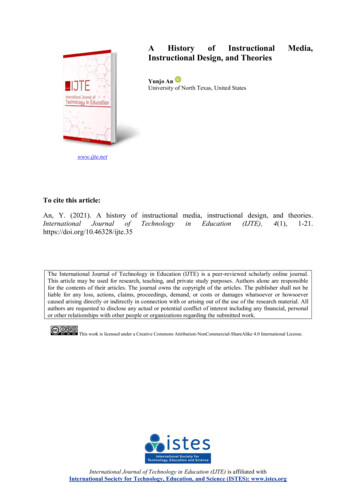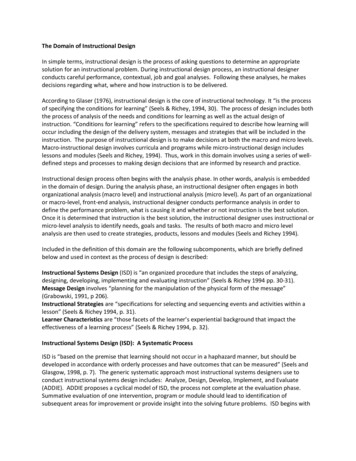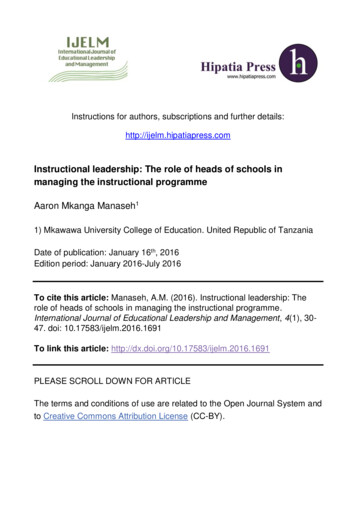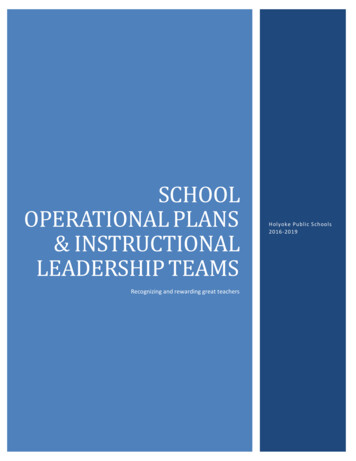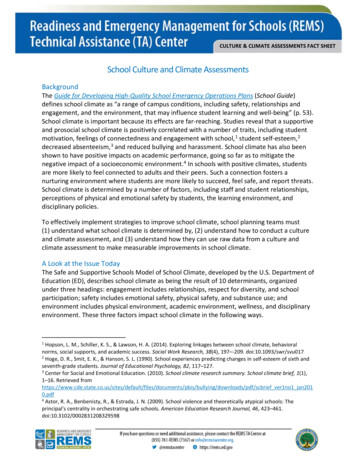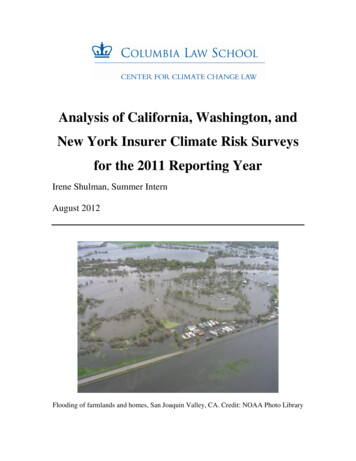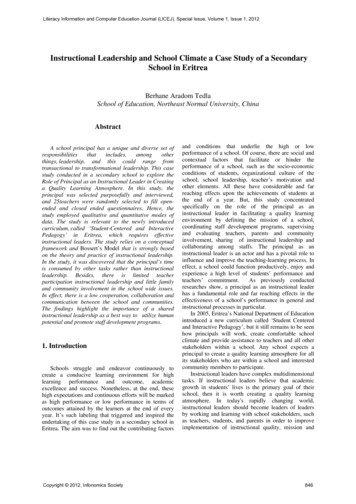
Transcription
Literacy Information and Computer Education Journal (LICEJ), Special Issue, Volume 1, Issue 1, 2012Instructional Leadership and School Climate a Case Study of a SecondarySchool in EritreaBerhane Aradom TedlaSchool of Education, Northeast Normal University, ChinaAbstractA school principal has a unique and diverse set ofresponsibilitiesthatincludes,amongotherthings, leadership, and this could range fromtransactional to transformational leadership. This casestudy conducted in a secondary school to explore theRole of Principal as an Instructional Leader in Creatinga Quality Learning Atmosphere. In this study, theprincipal was selected purposefully and interviewed,and 25teachers were randomly selected to fill openended and closed ended questionnaires. Hence, thestudy employed qualitative and quantitative modes ofdata. The study is relevant to the newly introducedcurriculum, called ‘Student-Centered and InteractivePedagogy’ in Eritrea, which requires effectiveinstructional leaders. The study relies on a conceptualframework and Bossert’s Model that is strongly basedon the theory and practice of instructional leadership.In the study, it was discovered that the principal’s timeis consumed by other tasks rather than instructionalleadership. Besides, there is limited teacherparticipation instructional leadership and little familyand community involvement in the school wide issues.In effect, there is a low cooperation, collaboration andcommunication between the school and communities.The findings highlight the importance of a sharedinstructional leadership as a best way to utilize humanpotential and promote staff development programs.1. IntroductionSchools struggle and endeavor continuously tocreate a conducive learning environment for highlearning performance and outcome, academicexcellence and success. Nonetheless, at the end, thesehigh expectations and continuous efforts will be markedas high performance or low performance in terms ofoutcomes attained by the learners at the end of everyyear. It’s such labeling that triggered and inspired theundertaking of this case study in a secondary school inEritrea. The aim was to find out the contributing factorsCopyright 2012, Infonomics Societyand conditions that underlie the high or lowperformance of a school. Of course, there are social andcontextual factors that facilitate or hinder theperformance of a school, such as the socio-economicconditions of students, organizational culture of theschool, school leadership, teacher’s motivation andother elements. All these have considerable and farreaching effects upon the achievements of students atthe end of a year. But, this study concentratedspecifically on the role of the principal as aninstructional leader in facilitating a quality learningenvironment by defining the mission of a school,coordinating staff development programs, supervisingand evaluating teachers, parents and communityinvolvement, sharing of instructional leadership andcollaborating among staffs. The principal as aninstructional leader is an actor and has a pivotal role toinfluence and improve the teaching-learning process. Ineffect, a school could function productively, enjoy andexperience a high level of students’ performance andteachers’ commitment.As previously conductedresearches show, a principal as an instructional leaderhas a fundamental role and far reaching effects in theeffectiveness of a school’s performance in general andinstructional processes in particular.In 2005, Eritrea’s National Department of Educationintroduced a new curriculum called ‘Student Centeredand Interactive Pedagogy’, but it still remains to be seenhow principals will work, create comfortable schoolclimate and provide assistance to teachers and all otherstakeholders within a school. Any school expects aprincipal to create a quality learning atmosphere for allits stakeholders who are within a school and interestedcommunity members to participate.Instructional leaders have complex multidimensionaltasks. If instructional leaders believe that academicgrowth in students’ lives is the primary goal of theirschool, then it is worth creating a quality learningatmosphere. In today's rapidly changing world,instructional leaders should become leaders of leadersby working and learning with school stakeholders, suchas teachers, students, and parents in order to improveimplementation of instructional quality, mission and846
Literacy Information and Computer Education Journal (LICEJ), Special Issue, Volume 1, Issue 1, 2012goal setting, communication, problem solving, sharedinstructional leadership, staff coordination anddevelopment programs, supervision and evaluation, andcollaboration among stakeholders .The role of a principal has become dramaticallymore complex, overloaded, and unclear over the pastdecades. Indeed, the role of a principal as aninstructional leader is highly important and complex innature and it is in a state of continuous transformation,shifting and progressing from a principal as aninstructional leader or master teacher, to a principal as atransactional leader and, most recently, to the role oftransformational leader[1].Numerous literatures have precisely and conciselyshowed the importance of the role of a principal as aninstructional leader to improve and promote a qualitylearning and teaching through a shared andcollaborative instructional leadership [2, 3, 1].A principal as instructional leader is an iconicfigure; however, as research clearly indicates, mostprincipal’s time is wasted on other duties rather thanspent on instructional tasks and roles. It was calculatedthat 62.2% of the principal’s time is preoccupied onschool management related issues; 6.2% of their time isdirected and focused on program issues, such asmonthly and yearly plans of a school. Similarly, aprincipal executes a lot of tasks and functions each day,but from the numerous tasks only 11% are related to therole of instructional leadership [4].A common and visible complaint from principals isthat, although they would like to spend much of theirtime on instruction related issues, such as teaching,learning, professional staff development, curriculumdevelopment and implementation, and instructionalleadership, their time is so exhausted with things likepaperwork, phone calls, and student discipline referrals.In the end, they simply don’t have time to deal withinstructional leadership tasks that most directly anddeeply impact teaching and learning [5]. However, it isproposed that if schools are to improve and progresssmoothly and properly, the school principal should notlet other daily duties intermeddle with the ntation [2]. It is true that principals areoverloaded with roles and responsibilities, but there aremany stakeholders within the school who can carry theburdens, if the principal promotes cooperation andshares instructional leadership with them.The research question that guides this study is, Is aSchool Principal as an Instructional Leader creates aquality learning atmosphere or not? To answer thisresearch question the following instruments were used:1. What does it mean to be by an instructional leader?2. How does a School Principal as an InstructionalLeader spend his/her time?Copyright 2012, Infonomics Society3. How does the principal produce and shape a schoolculture of learning, and provide an intellectualstimulation?The purpose of this case study is directed towardsexploring a Principal’s Role in Creating a QualityLearning Atmosphere and to identify and investigatewhat practices of a principal would promote and supporta quality learning atmosphere.2. Literature ReviewInstructional leadership is defined differently bydifferent scholars and researchers. Researchers andscholars acknowledge that there is no single cleardefinition of instructional leadership or specificguideline as to what a principal as an instructionalleader does in a school. They build up their owndefinitions, and as a result of this, meanings varyconsiderably from one researcher or practitioner toanother. This lack of clarity and consistency indefinition has resulted in part of the problem [3]. Roadsigns exist, but no maps are yet available for sale [6].Instructional leadership is defined as the role that istaken by a principal in a school to execute an effectiveinstruction by creating a quality and favorable climate[7, 8]. It is also defined narrowly as a task that focuseson leadership functions directly related to the teachingand learning process; whereas in a broader view it is afunction that contributes to student learning, includingmanagerial behaviors [8]. Instructional leadershipconsists of those actions that a particular principal takesand delegates to others in order to promote growth instudent learning [9].2.1 Effective Principal as an InstructionalLeaderEffective principals are expected to create andfacilitate a conducive teaching and learningenvironment. This implies that a principal must beknowledgeable about instructional effectiveness andstaff development [10]. Some researchers endorse theholistic view of the principal's role as an instructionalleader [11, 1]. The holistic definition and concept ofinstructional leadership and management is to be anactive, collaborative form of leadership where theprincipal struggles and works hard with and amongteachers to shape and build the school as a workplacepertinent to shared goals, teacher collaboration, teacherlearning opportunities, teacher certainty, teachercommitment, and student learning[1].An effective instructional leadership is defined assetting and creating an environment of greatexpectations for all stakeholders and learners,847
Literacy Information and Computer Education Journal (LICEJ), Special Issue, Volume 1, Issue 1, 2012promoting collegial and collaborative relationshipsamong educators and creating a commitment amongstaff and students toward a school’s goals, facilitatingand encouraging teachers to spend their time on directinstruction, encouraging staff development programs,supervision and evaluation, and being a dynamic andeducative leader [12]. It is maintained that an effectiveprincipal invests in teachers with necessary resourcesand instructions [13], and in the meantime a principalmaintains a congruence and consistency of theeducational program [14].Seven steps have been identified for an effectiveinstructional leadership, such as establishing clearinstructional goals, being resourceful for staff, creatinga school culture and climate conducive to learning,communicating the vision and mission of the school,setting high expectations for staff, developing teacherleaders, maintaining positive attitudes toward students,staff, and parents [15].Unlike the conventional notion of instructionalleadership, sharing instructional leadership is aninclusive concept that is compatible with competent andempowered teachers [16]. Teachers’ participation andinvolvement in shared instructional leadership takesplace both formally and informally as teachers assumemore leadership responsibility when they interact withother stakeholders and adults in the school community.They implement reforms to improve their professionalpractice, or learn together with their school colleaguescollaboratively [17].It is also perceived that the role ofthe principal as an instructional leader, in models of thefuture, will be encouraging a collaborative atmospherefor teachers to play a central role in the effectiveness orimprovement of a school [1]. This requires an activepivotal role of the principal to facilitate a conduciveenvironment by motivating the staff and studentsthrough reaching out to the community, and continuallyimproving and changing the school [18]. However,school management and instructional leadership are twodifferent and distinct tasks that cannot be performed ordone at a time by a single individual. It is a stronglyagreed that teacher empowerment, in which teachershave significant input and contribution into decisionsconcerning instruction, is indispensable. Moreover,others argue that well-managed schools enable realinstructional leaders to empower teachers who cancreate the effective school reforms they are seeking[19].2.2. ConceptualizationsInstructional LeadershipandModelofThe past 25 years have witnessed the emergence ofnew conceptual models in the field of educationalCopyright 2012, Infonomics Societyleadership. However, two of the foremost models thatare measured by the number of empirical studies, areinstructional leadership and transformational leadership[20]. Instructional leadership models have appeared inthe early 1980s based from early conducted research onseveral effective schools [21]. These bodies ofresearches clearly identified strong and directiveleadership focused on curriculum and instruction fromthe principal as a characteristic of elementary schoolsthat were effective at teaching children in poor urbancommunities. With the advent of school restructuring inNorth America during the 1990s, scholars, researcherand practitioners have begun to popularize leadershipterms, such as shared leadership, teacher leadership,distributed leadership, and transformational leadership[20]. The appearance of these leadership terms ormodels vividly indicated that a broader dissatisfactionwith the existing instructional leadership model, whichmany believed that too much focus on a principal as thecentre of expertise, power and authority. Although thereare different of conceptual models, over the past 25years of research into area of educational leadership,two major approaches have predominated greatly, suchas instructional leadership and transformationalleadership. Studies starting from the early to late 1980swere dominated by an instructional leadershipconceptualization, which are drawn from effectiveschools literature.For the purpose of this research study, Bossert’sModel of 1982 was used to show the principal’sinfluence on school climate, instructional organizationand student achievement. According to this model, theprincipal’s managerial behavior is shaped by schoolcontext and personal characteristics, and in turn theprincipal directly affects the school and instructionalorganization, and indirectly influences schoolperformance (student achievement).Bossert’s Model, 1982This model of instructional leadership provides aspotlight for the improvement of instructional quality,such as learning, teaching and working collaborativelywith staffs, students, parents, communities and848
Literacy Information and Computer Education Journal (LICEJ), Special Issue, Volume 1, Issue 1, 2012interested groups. It’s however the responsibility of aprincipal to create a strong school culture and climatethat assists staffs to collaborate and redesign aninstructional program.The role of a principal as an instructional leader, inmodels of the future, will be encouraging acollaborative atmosphere for teachers to play a centralrole in the effectiveness or improvement of a schoolculture. However, it will require active and pivotal roleof the principal to facilitate a conducive environment bymotivating staffs and students through reaching out thecommunity, and continually improving and changingthe school (Fullan, 1991).3. Data Presentation, Description andInterpretation3.1 Research findingsTable-1: Teachers’ ProfileGenderQualificationTeachingexperience inyearsLeadershipexperience(Noof teachers inleadershipposition)Male 21Female 4Diploma 3,B.A/B.SC 22,MA/MSC 00-5 75-10 810-15 515-20 920-25 225-30 1As Department Head 5As Assistant Principal 3As Principal 2As School administration 0The school principal in the case study has seven yearsof experience in a leadership position, taught for fifteenyears before became a principal, and currently, heteaches a class every day. He was trained as a teacher,not as a leader of a school. He learned leadership on thejob by trial and error. He reported that he did not eventake a workshop or any form of leadership training. Hefurther reported that it’s a problematic issue toexperiment leadership on the real ground without aninitial learning at least theoretically, for it took me along journey to explore and understand the scope ofprincipalship. Sometimes, roles and responsibilities goout beyond and out of control, and don’t know how todeal with it and get the assistance of staffs. However,through time, I’ve learned somehow to comprehend thenature and scope of leadership and make division oflabor among teachers by empowering. The principalalso indicated that early in the beginning of my career asCopyright 2012, Infonomics Societya principal, most of time was scattered and suspended toevery detail of what happened within the school.However, the principal added, currently most of mytime is consumed in managerial tasks, planning, officeworks, paperwork, student discipline, budget, seminarsand the like that I does not have adequate time to dealwith instructional tasks.The principal showed that the school functions as perpreset guidelines and philosophy. The mission of theschool falls under the umbrella of the Ministry ofEducation (MOE), and executes the imposed curriculumdeveloped by the Department of National Curriculum.Though the curriculum developed without teachers’participation, it was piloted in a school before actualimplementation. However, the implementation processremains problematic and uncertain, for it requires highnumber of teachers and expertise, and democraticschool leadership. In Eritrea, teachers were/are trainedin the approach of teacher centered methodology, not asstudent centered and interactive pedagogy. Besides,school leadership is at an infant or immature stage.Principals are experienced teachers, not experiencedleaders. It takes them a tremendous amount of time tolearn on the job and become real school leaders. Thismade the newly introduced curriculum impractical.For the past twenty years, the state of Eritrea ingeneral and Ministry of Education in particular, havemade a lot of amendments and brought fundamentalchanges to thrive the educational philosophy andsystem. In the entire country a number of schools built,infrastructure changed and students’ enrollmentincreased, but still the school leadership remainsunchanged and a problematic.The principal in the case study reported that almosteverything in Eritrean schools is changed, but the natureleadership is yet unknown and principals take leadershipresponsibility as personal power to exercise fear andcreate threats. Principals don’t understand instructionalleadership as a role to promote an effective teachinglearning process, the principal added. Besides, theprincipal explained that in the ordinary sense, trueprincipalship endorses the sharing of instructionalleadership, collaboration, promotes staff developmentprograms and calls for an immediate involvement ofparents and community members, but in reality it’s hardto make it happen.Truly understood and effective instructionalleadership is very important as an engine to mobilizeteachers to teach wholeheartedly, motivate students toexplore and learn, and community members to involveand become important agents in a school. The aspirationto coach and participate families and communities, andthe motivation to mobilize and utilize the resources of aschool are the outcome of visionary instructionalleadership.849
Literacy Information and Computer Education Journal (LICEJ), Special Issue, Volume 1, Issue 1, 2012A school is an organ that receives inputs, undergoesprocesses and ultimately pumps byproducts as outs ofinputs. A principal as a model of learning and centralfigure of change, need to consider his school as anorganism of potential scientists, philosophers andleaders, not as an organizational structure ofbureaucratic administration and management . Theparticipants clearly indicated that real school culture isnot the outcome clever technique, but of a schoolleadership that treats a school as a place of humanrealization. The mission statement of the Ministry ofEducation supports these findings, but practically theschool employs old fashioned practices that don’tsupport the ideal development of cognitive, social andmotor skills of students. Besides, a school as anorganism should constitute home, family andcommunities, but the study revealed that there is alimited of these entities in the school wide decisions thatpushes an increased students’ drop out and teacherabsenteeism.In the modern education system, school-communityrelations are very important and have far reachingeffects to students’ achievements. The principalreported that he endorses a friendly climate to workcollaboratively with teachers and shares instructionalleadership authority that perhaps helps to create aquality learning atmosphere and ensures an academicexcellence. However, 75% of the sample teachersreported that the principal does not share instructionalleadership as it should be. One unique respondent fromthe teachers reported “real teacher motivation is not anoutcome of salary, but outcome of a conducive workenvironment resulting from a shared instructionalleadership, visionary mission and collaboration’’.Teachers feel a sense of ownership and responsibilitywhen the right environment is in place, they added.The sample teachers are bored and switched off bythe existing school leadership and could not thinkoutside of their classroom. Their participation inimproving instructional leaderships doesn’t exist at all.Some teachers from the sample study which is 35% ,take personal power, initiative, influence and interest tobe involved in decision making processes, students’discipline matters, and warmly invite parents so as toparticipate in disciplinary matters and academicprogress of their children; this in turn helps parents tobecome familiar with the school leadership, mission andculture. It was also revealed that the principal is notdemocratic enough to empower teachers that perhapswill help them to participate in the decision-makingprocess of the school.With increased teacherinvolvement, school decisions become an effective toolfor focusing on both the staff’s and students’ needs andoutcomes [22]. True principals capture good attitudeand cultivate the spirit of their teachers and ultimatelyCopyright 2012, Infonomics Societyempower them to influence the school climate andimprove instructional effectiveness.The case study discovered that the school does notprovide all the necessary resources to teachers andstudents. The school lacks the adequate teaching aids,textbooks, laboratory equipment, computer laboratory,free internet café, a library with adequate supplementarybooks, and other related instructional materials.Providing the resources that are needed for learning tooccur is one of the main tasks of instructionalleadership. It’s a treasured task that a principal as aninstructional leader should make resources available andallocate wisely and effectively [23].The research further revealed that the school provideslittle professional development to teachers, schooladministrators, and the deputy principal that focus onincreasing their potential, personal competency andability to recognize that enables them to foster anexcellent teaching and learning atmosphere. Mostprofessional development programs are conducted at anational level by the Ministry of Education.Coordinating staff development programs is the mainrole and function of a principal as an instructional leaderin facilitating a quality learning atmosphere [22]. Theprincipal explained that a principal alone could not carrythe issue of staff development program.Schooladministrators and assistant principals shouldunderstand the integral roles of professionaldevelopment in the operation of the school and organizethem around teaching-learning processes that in turnwill help and provide teachers and other staff theopportunities to upgrade their profession in theirrespective areas, the principal insisted. Furthermore, theprincipal explained that on a monthly basis the schoolcalls teachers and other staffs for a meeting/seminar inorder to evaluate the past achievements and understandthe status quo of the school, then accordingly to planahead for the coming academic year. In so doing, theprincipal explained, the school stakeholders, particularlyteachers, feel a sense of ownership, belongingness, andbecome passionate to explore and update theirprofession. In addition to this, the principal reported thatthe school seeks a collaboration and new partnershipwith other schools, colleges and universities for the sakeof staff development programs. However, it’s not yethappened in reality; it demands a lot of efforts to makeit happen.The principal claims that teacher supervision andevaluation is one of the best ways to enhance andupgrade teacher profession. The main focus is to utilizeteachers’ potential, and in turn maximizes students’learning and achievement. Teacher supervision andevaluation enables a school to maintain standards andmake check and balance. The principal employs naturalobservation and scheduled supervision as a critical850
Literacy Information and Computer Education Journal (LICEJ), Special Issue, Volume 1, Issue 1, 2012aspect of evaluation. However, the principal explained,to undertake this role effectively it’s necessary that aprincipal should have a thorough knowledge ofsupervision, mastery of the subject matter and achecklist of evaluation form that corresponds theobjectives of instruction. Knowing when and how tosupervise and under what circumstance is veryproblematic for school principals, he explained.The principal reported that the newly introducedcurriculum requires an inclusive leadership, high levelof coordination, effective supervision and evaluationbecause it is introduced on the basis of student-centeredand interactive pedagogy. Sometimes teachers have ahard time in organizing and handling interactivediscussions within the class as the teacher-student ratioranges from 1:50 to 1:70. Because of this, he added, it’sa policy of the school to observe naturally, randomlyand intentionally (scheduled) to conduct teachersupervision and evaluation. The school after supervisionand evaluation briefs teachers in a friendly manner theirstrength and weaknesses based on the newly introducedcurriculum. In effect, this helps to foster effectiveteaching, and above all, ensures teachers’ confidence,competence, capacity, flexibility, collaboration, andindependence. Furthermore, the principal stressed thatteacher evaluation process is based on the belief that thenature of teaching profession is dynamic as well as acontinual process. The teacher evaluation planemphasizes the relationship between teaching andlearning, and school improvement and leadership.In this paper, it’s discovered that effective instructionalleadership is indispensable for a school climate andimprovements, among which the following are worthmentioning: Planning and preparation: After supervisionand evaluation, teachers plan and prepare wiselyto ensure the desired expectations are met for allstudents. It helps to avoid delaying ofcurriculum implementation. The classroom environment: Teachers becomemore responsible and know how to build aneffective classroom atmosphere. This is one ofthe most problematic and critical issues forsome teachers to make it happen. More thananything, a quality learning atmosphere mattersa lot more than other school factors. Instruction: Through continuous supervisionand evaluation, teachers have come to know,learn and work hard to master the subjectmatter. Not only content-wise, but alsopedagogical knowledge. Monitoring Student Achievement: a wise andeffective supervision and evaluation of teachersCopyright 2012, Infonomics Society by a principal in turn produces a good studentevaluation by teachers.Professional Responsibilities: Eventually as anaggregate outcome, teachers think rationally andcritically about their profession, practices andlearning experiences. In effect, they start towork collaboratively and create collegiality inthe learning community of a school and outsideit.3.1 Summary, Discussion and ConclusionThe findings reveal that the principal as aninstructional leader does not provide an adequateconducive climate for teaching and learning process, buthe recognizes the importance of collaboration andsharing instructional leadership. The climate ofcollaboration and sharing instructional leadership boostteachers’ spirit. This in turn provides the students withthe condition of effective learning and highachievement. However, the role of principal as aninstructional leader remains only as a role rather than afunction, and it was also discovered that the principalhas not been trained as a principal, but as a teacher only.This negatively affects the concept of teacherleadership, and parent and community participation as away of school effectiveness and improvement.Furthermore, it’s discovered that the principal consumesmost of his time dealing with managerial issues,meetings, paperwork, planning, budgeting, studentdiscipline, and office tasks that the principal does nothave adequate time to deal with instructional processes.In the mean time, it was also revealed that empiricalresearch is important for the role of principal as aninstructional leader in order to promote and embracevisionary school leadership in Eritrean context. Ideally,the role of principle would foster participative,collaborative and shared instructional leadership amongteachers. These concepts are crucial for the teaching andlearning processes, teacher satisfaction, and for highstudent achievement. In the case study, it wasdiscovered that there is lack of teacher readiness,inaccessibility of adequate resources, limitedparticipation, and lack of teachers’ in-service training.This implies that there is no a conducive environmentfor the teaching-learning process to be effectivelyimplemented. A principal a
Instructional leadership is defined as the role that is taken by a principal in a school to execute an effective instruction by creating a quality and favorable climate [7, 8]. It is also defined narrowly as a task that focuses on leadership functions directly related to the teaching and learning process; whereas in a broader view it is a
